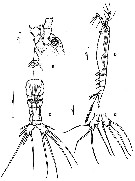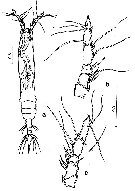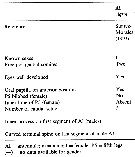|
|
 |
Fiche d'espèce de Copépode |
|
|
Monstrilloida ( Ordre ) |
|
|
|
Monstrillidae ( Famille ) |
|
|
|
Monstrilla ( Genre ) |
|
|
| |
Monstrilla ciqroi (Suarez-Morales, 1993)) (F) | |
| | | | | | | Syn.: | Monstrillopsis ciqroi Suarez-Morales, 1993 a (p.351, Descr.F, figs.F, Rem.); Grygier, 1995 a (p.57, 61); Suarez-Morales & Gasca, 1998 a (p.112); Suarez-Morales & al., 2006 (p.102, Tab.1) | | | | Ref.: | | | Suarez-Morales & al., 2006 (p.102: Rem.: species transferred to the genus Monstrilla .); Suarez-Morales & Castellanos-Osorio, 2019 (p.120: Rem, Key) |  issued from : E. Suarez-Morales in J. Crustacean Biol., 1993, 13 (2). [p.353, Fig.3]. Female (from Bahia de la Ascension, Yucatan Peninsula): a, head (left lateral view); b, habitus (lateral); c, urosome (dorsal); d, P5 (ventral). Nota: - Cephalothorax 0.65 of entire length of body. -, Oral papilla located 0.17 way back along cephalothorax. - Eyes present; dorsal ocelli enlarged, round. - P5 1-segmented with inner (endopodal) and outer (exopodal) ramus; inner ramus bearing 1 long seta and slightly shorter than outer ramus bearing 3 subequal setae; inner ramus with small protuberance anterior to seta. - Urosome consisting of 5th pedigerous genital double -somite, and 2 free abdominal somites. - Length ratio of genital double -somite and abdominal somites 70.6 : 17.6 : 11.8 = 100. - Genital double-somite with dorsal incomplete suture (apparent intersegmental division in dorsal view). - Ovigerous spine at least 3.4 times longer than urosome.
|
 issued from : E. Suarez-Morales in J. Crustacean Biol., 1993, 13 (2). [p.354, Fig.4]. Female: a, habitus (dorsal); b, left A1 (dorsal); c, right A1 (dorsal). Nota: -A1 4-segmented. - Caudal rami about 1.3 times longer than wide, bearing 5 setae; 1seta borne on proximal outer margin, another borne on distal inner margin, and remaining 3 on terminal margin; all setae strongly developed and with almost same length and breadth.
|
 issued from : E. Suarez-Morales in J. Crustacean Biol., 1993, 13 (2). [p.351]. Female: Armament formula of swimming legs.
|
 Issued from : E. Suarez-Morales, A. Bello-Smith & S. Palma in Zool. Anz., 2006, 245. [p.103, Table 1]. As Monstrillopsis ciqroi. Stuctural characteristics. Morphological characters for comparative morphology of the species assigned to the genus Monstrillopsis by different authorities. See : M. dubia, M. dubioides, M. fosshageni, reticulata, sarsi, Cymbasoma gracilis, M. ferrari, M. zernovi, M; angustipes, Monstrillopsis sp.
| | | | | NZ: | 1 | | |
|
Carte de distribution de Monstrilla ciqroi par zones géographiques
|
| | | | Loc: | | | Mexico (Bahia de la Ascension, Yucatan Peninsula) | | | | N: | 1 | | | | Lg.: | | | (756) F: 3,1; {F: 3,10} | | | | Rem.: | Depth sampling: 1.5 m.
For Suarez-Morales (1993 a) the presence of 4 apparent abdominal somites, this species would fit within the genus Strilloma , according to the identification key of Isaac (1975). However, a superficial suture subdividing the genital double-somite occurs in wM. ciqroi, and varies from absent to complete throughout the group. Although the urosome often appears 4-segmented because of the superficial suture, it really comprises a doubble genital somite plus 2 free abdominal somites. This is why Huys & Boxshall (1991) did not recognize Strilloma as a valid genus. This fact may cause mistakes in determining the genus. However, this new species can easily be placed in Monstrillopsis by the forward location of the oral cone, the well-developed eyes, and the incomplete division of the genital double-somite. But differs from most other species of Monstrillopsis by the P5 having an inner ramus bearing 1 seta.
This new species is more closely related to Monstrillopsis reticulata (Davis, 1949) which also bears a P5 inner ramus armed with 1 seta. However, both species differ: the armature of A1 is different, in reticulata, the first antennule segment shows no armature; the corresponding structure in ciqroi bears 1 short strong spine on the inner marginj; on the 2nd segment, reticulata shows 5 spines plus 1 seta, while ciqroi shows only 3 spines. The structure of the rami of P5 is also different; in reticulata, the inner ramus is slender and narrow, with no protuberances; in ciqroi the corresponding structure is wider and shows a small orotuberance on its inner proximal portion.The outer ramus of P5 in reticulata bears 3 terminal setae, the two inner of these arising very close together; this feature is not present in ciqroi, with the 3 corresponding setae being separated by the same distance. In reticulata, the ovigerous spines extend only slightly beyond the furcal rami (1.2 times the length of the abdomen), in ciqroi, these strictures extend well beyond the furcal rami (3.4 times the lengyh of the abdomen). Monstrillopsis reticulata is one of the smallest known monstrilloids (0.67-0.74 mm), while ciqroi is clearly a larger species.
Suarez-Morales & al. (2006) assigned to Monstrilla this new species. Suarez-Morales & Castellanos-Osorio (2019, p.120) consider eight species of Monstrilla recorded from different coastal or reef areas of the Mexican Caribbean.
| | | Dernière mise à jour : 05/03/2020 | |
|
|
 Toute utilisation de ce site pour une publication sera mentionnée avec la référence suivante : Toute utilisation de ce site pour une publication sera mentionnée avec la référence suivante :
Razouls C., Desreumaux N., Kouwenberg J. et de Bovée F., 2005-2025. - Biodiversité des Copépodes planctoniques marins (morphologie, répartition géographique et données biologiques). Sorbonne Université, CNRS. Disponible sur http://copepodes.obs-banyuls.fr [Accédé le 16 octobre 2025] © copyright 2005-2025 Sorbonne Université, CNRS
|
|
 |
 |






